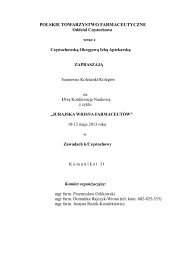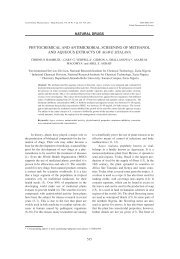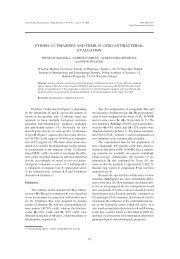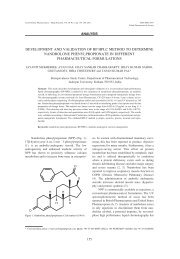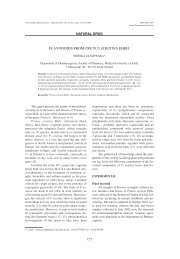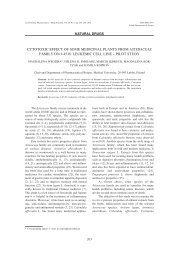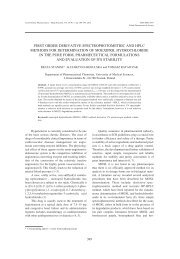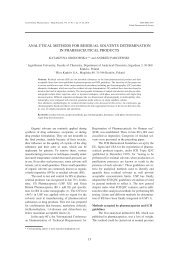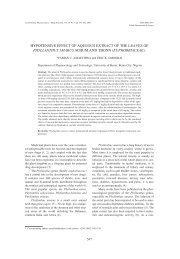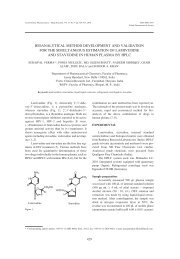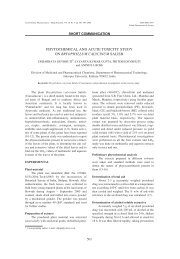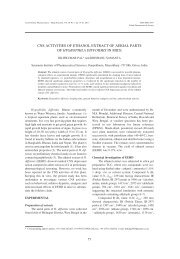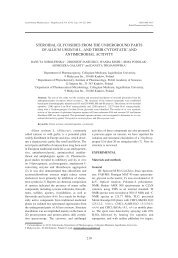identification and analysis of drugs in the solid state by 13c cpmas nmr
identification and analysis of drugs in the solid state by 13c cpmas nmr
identification and analysis of drugs in the solid state by 13c cpmas nmr
Create successful ePaper yourself
Turn your PDF publications into a flip-book with our unique Google optimized e-Paper software.
Identification <strong>and</strong> <strong>analysis</strong> <strong>of</strong> <strong>drugs</strong> <strong>in</strong> <strong>the</strong> <strong>solid</strong> <strong>state</strong> <strong>by</strong>... 297<br />
Figure 1. 13 C <strong>solid</strong> <strong>state</strong> spectra <strong>of</strong> suxamethonium chloride recorded with different magic angle sp<strong>in</strong>n<strong>in</strong>g speeds.<br />
contact times t cp are illustrated <strong>in</strong> Figure 3.<br />
Protonated carbon atoms have fast polarization rate<br />
<strong>and</strong> <strong>the</strong> signals <strong>of</strong> methylene groups are <strong>in</strong>tense for<br />
short t cp . As expected, quaternary carbon atoms<br />
need longer time, especially C=O reach<strong>in</strong>g <strong>the</strong> maximum<br />
with t cp = 3.5 ms. This effect should be taken<br />
<strong>in</strong>to account <strong>in</strong> quantitative measurements, <strong>and</strong> may<br />
be helpful <strong>by</strong> assignment <strong>of</strong> <strong>the</strong> resonances, e.g. dist<strong>in</strong>guish<strong>in</strong>g<br />
quaternary carbon atoms from CH or<br />
CH 2 ones.<br />
In order to obta<strong>in</strong> <strong>the</strong> values <strong>of</strong> cross-polarization<br />
time constant T CP <strong>and</strong> proton sp<strong>in</strong>-lattice relaxation<br />
time <strong>in</strong> <strong>the</strong> rotation frame T 1ρH for <strong>the</strong> I-S<br />
model, an unrestricted fit <strong>of</strong> <strong>the</strong> experimental data to<br />
<strong>the</strong> equation (1) was performed:<br />
(1) I(t) = A(1-T CP /T 1ρH ) -1 [exp(- t/ T 1ρH ) ñ exp(- t/<br />
T CP )], where A is <strong>the</strong> <strong>in</strong>tensity amplitude.<br />
Cross-polarization <strong>in</strong> <strong>the</strong> C-H bonds (CH 2 <strong>and</strong><br />
CH 3 groups) proceeds accord<strong>in</strong>g to <strong>the</strong> I-I*-S model.<br />
Figure 2. Intensity <strong>of</strong> isotropic l<strong>in</strong>e <strong>and</strong> two sets <strong>of</strong> sp<strong>in</strong>n<strong>in</strong>g side<br />
b<strong>and</strong>s <strong>in</strong> <strong>the</strong> spectra recorded at various sp<strong>in</strong>n<strong>in</strong>g speeds.



